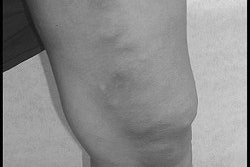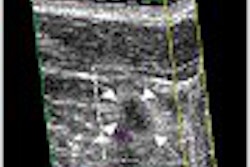CHICAGO - Power Doppler sonography, with a 3-D reconstruction component to assess neovascularization, is more effective than B-mode ultrasound in diagnosing and staging prostate cancer, according to a presentation Tuesday at the American Urological Association.
The modality "improves the reliability of sonography in the diagnosis and staging of prostate cancer," said Dr. Jean-Luc Sauvain, a urologist practicing at the Centre d'Imagerie Médicale in Vesoul, France. By identifying areas of neovascularization, power Doppler ultrasound can visualize the vessels that cross the prostatic capsule, he said.
Sauvain and his co-investigators recruited 282 suspected prostate cancer patients who had prostate-specific antigen (PSA) levels exceeding 4 ng/ml, as well as 41 normal controls. All 323 subjects underwent power Doppler sonography.
The investigators sought to define the three types of blood supply in the prostate: an avascular prostatic capsule with regular borders, an avascular capsule with irregular borders, and a capsule with vessels extending across it. The third scenario would cause the physician to suspect spreading of the tumor beyond the capsule, he said.
The findings on the power Doppler and B-mode images were then compared to the histological findings on the biopsies for the 282 subjects with suspected cancer, and also to the pathology reports on the 63 patients who went on to undergo radical prostatectomy.
The investigators diagnosed cancer in 157 of the 282 subjects in whom cancer was suspected (55.7%). The power Doppler modality had an overall 92.4% sensitivity, compared to a sensitivity of 87.9% for B-mode ultrasound. The modalities had a specificity of 72% for power Doppler and 57.6% for B-mode. Power Doppler had a negative predictive value of 80.6%, Sauvain reported.
The investigators detected capsular penetration in three of the 27 patients with regular avascular capsules (11%) and in 16 of the 18 patients with vessels extending across the capsule. Capsular neovascularization was a highly significant predictor of the spread of cancer beyond the capsule, at a probability of less than 0.0001, according to Sauvain.
Time will tell whether power Doppler with 3-D vascular sonography can detect the fine vessels that are typical of the neovascularization found in malignancies, said Dr. Michael Brawer, commenting on the study.
"This concept of imaging capitalizes on the fact that all tumors have to generate a blood supply once the tumor is larger than 1 mm," said Brawer, a urologist specializing in prostate cancer and the director of the Northwest Prostate Institute in Seattle, Washington. "We have demonstrated that the prostate is similar to every other malignancy regarding neovascularity. The more aggressive the tumor, the more hypervascular it will be."
The standard prostate ultrasound does not delineate vascularity, he added. "The problem is that the size of the vessel delineated with Doppler is larger than the vessels found in malignancies," Brawer said. "Are our imaging modalities sensitive enough to identify the small vessels characteristic of cancer? I don’t know."
By Paula MoyerAuntMinnie.com contributing writer
April 30, 2003
Related Reading
Intramuscular gene transduction enhanced using microbubbles with ultrasound, February 25, 2003
Second-generation microbubbles enhance ultrasound's clinical utility, August 27, 2002
For prostate cancer screening, microbubbles are too big, and the options too few, July 5, 2002
Adding 3-D to power Doppler US improves prostate cancer detection, March 25, 2002
Copyright © 2003 AuntMinnie.com



















